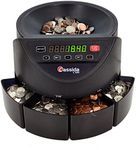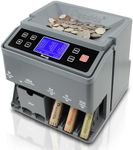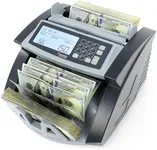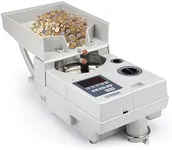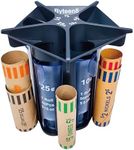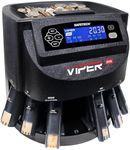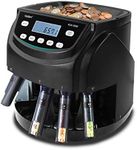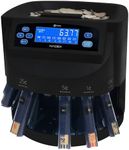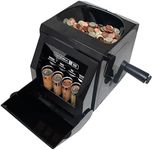Buying Guide for the Best Coin Counters
Choosing the right coin counter can save you a lot of time and effort, especially if you handle a large volume of coins regularly. Whether you are a business owner, a bank employee, or someone who just wants to manage their coin collection efficiently, understanding the key specifications of coin counters will help you make an informed decision. Here are the main features to consider when selecting a coin counter that best fits your needs.Counting SpeedCounting speed refers to the number of coins a machine can count per minute. This spec is important because it determines how quickly you can process your coins. If you handle a large volume of coins daily, a higher counting speed will save you significant time. Coin counters typically range from 200 to 2,000 coins per minute. For small businesses or personal use, a speed of 200-600 coins per minute may be sufficient. For larger operations, look for machines that count 1,000 coins per minute or more.
Hopper CapacityHopper capacity is the maximum number of coins the machine can hold at one time. This is important because a larger hopper means you can count more coins in one go without needing to refill the machine frequently. Hopper capacities can range from 200 to over 2,000 coins. For occasional use or small batches, a hopper capacity of 200-500 coins might be adequate. For high-volume counting, look for a machine with a hopper capacity of 1,000 coins or more.
Sorting CapabilitySorting capability refers to the machine's ability to separate different denominations of coins. This is crucial if you need to organize coins by type, such as pennies, nickels, dimes, and quarters. Some coin counters only count coins, while others can sort them into separate bins. If you need to sort coins, look for a machine with multiple sorting bins. For basic counting needs, a single-bin counter may suffice, but for more complex tasks, a multi-bin sorter is ideal.
Batching FunctionThe batching function allows you to set the machine to count a specific number of coins before stopping. This is useful for preparing bank deposits or packaging coins in standard rolls. The ability to batch coins can save you time and ensure accuracy. Machines with batching functions often allow you to set different batch sizes for different denominations. If you frequently prepare coin deposits or rolls, this feature is essential. For general counting, it may not be as critical.
Display and InterfaceThe display and interface of a coin counter show the count results and allow you to control the machine's functions. A clear, easy-to-read display and user-friendly interface are important for efficient operation. Look for machines with digital displays that show the total count, value, and batch information. Some advanced models offer touchscreens and additional features like error messages and maintenance alerts. Choose a machine with a display and interface that you find intuitive and easy to use.
Counterfeit DetectionCounterfeit detection is a feature that helps identify fake coins. This is particularly important for businesses that handle large amounts of cash and need to ensure the authenticity of their coins. Some coin counters come with built-in counterfeit detection using various technologies like magnetic sensors and weight detection. If counterfeit coins are a concern for you, look for a machine with reliable detection capabilities. For personal use or small-scale operations, this feature might be less critical.
PortabilityPortability refers to the ease with which you can move the coin counter from one location to another. This is important if you need to use the machine in different places or store it when not in use. Portable coin counters are typically lightweight and compact. If you need a machine that can be easily transported, look for one that is under 10 pounds and has a compact design. For stationary use, portability may not be a significant factor.
